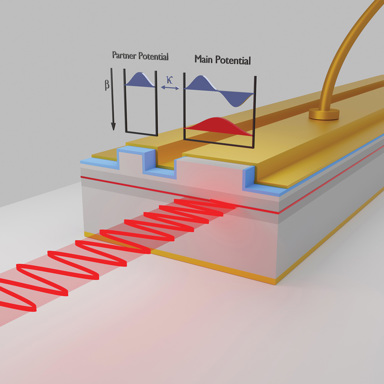 [Enlarge image]Experimental demonstration of quasi-PT symmetric edge-emitting lasers with high beam quality (M2 ~ 1.15) and high power levels (~400 mW).
[Enlarge image]Experimental demonstration of quasi-PT symmetric edge-emitting lasers with high beam quality (M2 ~ 1.15) and high power levels (~400 mW).
Non-Hermitian symmetries and their spontaneous breaking have emerged as a novel concept for engineering optical wave dynamics in photonics. In work published this year, we have demonstrated, for the first time, that parity–time (PT) symmetry between the fundamental and second-order modes of two coupled waveguide cavities can be used to build an electrically pumped, large-area, high-power edge-emitting laser that operates in the single transverse mode regime at room temperature.1
Since 2014 it has been shown that PT symmetry can enable engineering of microring lasers with single longitudinal2,3 and transverse4 modes. These studies have led to intense investigation of how non-Hermitian principles, combined with other symmetry concepts, might be used to engineer novel laser systems with enhanced performance, using platforms such as coupled ring resonators and photonic crystals. Despite rapid progress, however, all output light reported to date from non-Hermitian lasers has been incompatible with industrial standards for beam shape, beam quality and power. This has raised serious questions about the utility of non-Hermitian concepts in engineering laser systems under realistic conditions including carrier diffusion and thermal effects resulting from high-power emission.
Our work this year has overcome these roadblocks to leveraging non-Hermitian symmetries in laser design. The structure consists of two coupled edge-emitting laser waveguide cavities. The main cavity lasing waveguide has a large area and supports two optical modes, while the auxiliary waveguide supports only one mode. The waveguide dimensions are chosen to achieve phase matching between the second-order mode of the large-area waveguide and the auxiliary guide. Thus, under differential pump, these modes feature a shifted PT symmetry. In the unbroken PT regime, this arrangement spoils the quality factor of the supermodes of the entire system, leaving the fundamental mode of the main waveguide intact (at least to a first-order approximation that neglects off-resonant interactions).
Using electrical pumping, our team demonstrated high beam qualities (M2 ~ 1.15) and output powers up to 400 mW. To confirm that the observed performance is indeed a result of modal (or quasi) PT symmetry, we compared the results of the reported device with those obtained using a single-cavity laser and using coupled-cavity lasers with an intentionally introduced mismatch. The experimental results in both cases agreed with theoretical predictions.
Our results open the door for using non-Hermitian symmetries, together with other symmetry concepts (such as supersymmetry and topological invariants), for engineering realistic laser systems beyond proof-of-concept demonstrations.
Researchers
Enes Şeker, Babak Olyaeefar, Khalil Dadashi, Serdar Şengül and Abdullah Demir, Bilkent University, Ankara, Turkey
Mohammad Hosain Teimourpour and Ramy El-Ganainy, Michigan Technological University, Houghton, MI, USA
References
1. E. Seker et al. Light Sci. Appl. 12, 149 (2023).
2. H. Hodaei et al. Science 346, 975 (2014).
3. L. Feng et al. Science 346, 972 (2014).
4. H. Hodaei et al. Laser Photon. Rev. 10, 494 (2016).

